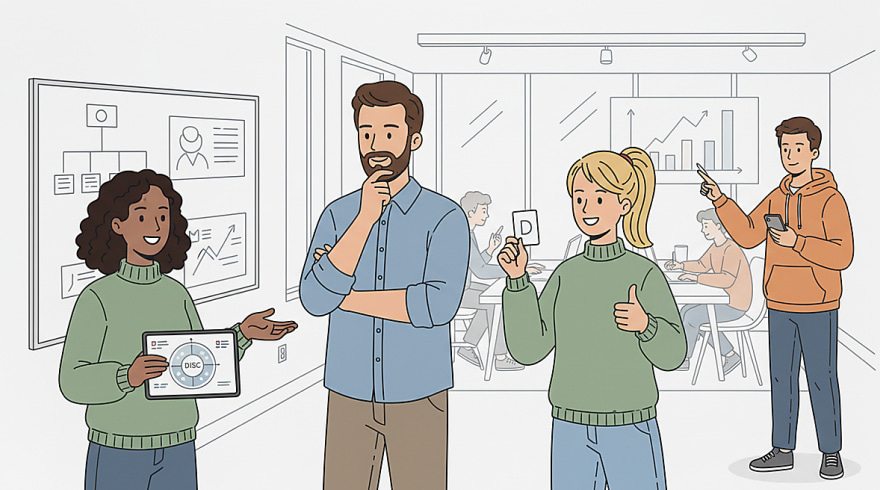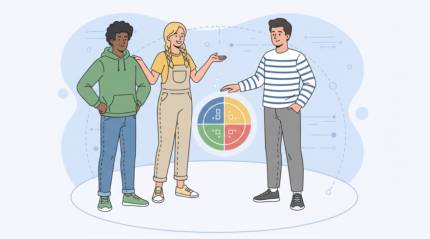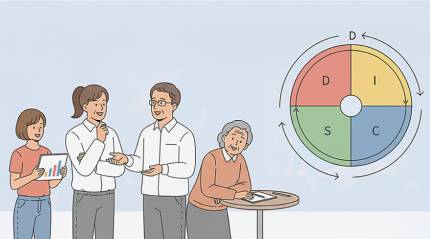Your Comprehensive Guide to Online DISC: Understand Styles and Grow Faster
- 7 October 2025

DISC is a practical behavioral framework that translates how people approach problems, influence others, pace their work, and follow rules. It distills tendencies into four style clusters Dominance, Influence, Steadiness, and Conscientiousness, so you can anticipate strengths, pressure points, and collaboration patterns. In the digital era, this model becomes especially convenient and scalable, allowing individuals and teams to gain clear, shared language about behavior and communication.
For busy professionals and learners, you might opt for an online DISC assessment that mirrors validated behavioral models. The web-based experience typically involves short, forced-choice items and yields immediate profiles with plain‑English interpretations. That means you can quickly map your natural style, spot likely blind spots, and identify practical tactics for meetings, sales calls, and conflict resolution.
People turn to DISC for many reasons: career clarity, leadership development, onboarding, or simply building rapport faster. Many seekers value a DISC assessment online free option when trialing before investing. With modern scoring and visual dashboards, you’ll see patterns like speed versus accuracy or autonomy versus collaboration, then translate those patterns into action steps. The result is not a label, but a starting point for smarter choices about how you plan, prioritize, and communicate under varying pressures.
Because digital questionnaires reduce friction, adoption tends to be higher than paper methods. If you prefer speedy feedback with interactive visuals, try a DISC test online that summarizes your quadrant strengths. You can then review your results against real-world scenarios, such as handling objections in sales, delegating tasks in projects, or preparing for cross-functional presentations. Over time, this shared vocabulary reduces misunderstandings and boosts predictable performance across your workflows.
- Identify behavioral drivers without lengthy interviews
- Gain a shared language for feedback and coaching
- Reduce friction in teamwork, sales, and service contexts
- Accelerate onboarding and career transitions
Benefits You Can Expect, From Self-Awareness to Team Performance
Self-awareness is the cornerstone of every high‑performing professional. When you understand how you respond to pressure, what motivates you, and which tasks energize you, you make smarter commitments and negotiate expectations effectively. Onboarding programs can leverage a free DISC assessment online to boost alignment among new hires. Managers can also adapt their approach, shifting from one-size-fits-all directives to tailored guidance that resonates with each person’s natural style.
In sales and customer success, knowing your pattern helps you pace conversations, decide when to probe versus summarize, and calibrate detail levels. Career changers often start with a free online DISC assessment to map transferable strengths. By aligning your communication tone with the other party’s cues, you reduce friction and increase trust, which translates into better close rates, smoother handoffs, and fewer escalations. The result is not just improved relationships, but measurable business outcomes.
Coaching and L&D teams benefit from focusing resources where they produce the greatest lift. Coaches frequently point clients to a free DISC profile test online to spark reflection before sessions. This pre-work makes conversations more targeted, allowing real-time practice of new behaviors tied to stretch goals. Over weeks and months, you can track progress by observing changes in meeting dynamics, response times, conflict cycles, and decision quality.
- Sharper self-awareness and language for growth
- Better stakeholder mapping and influence strategies
- Faster onboarding and smoother role transitions
- Higher team cohesion with fewer miscommunications
How to Choose a Quality Tool and Get the Most From Your Results
Not all questionnaires are built alike, so it pays to inspect methodology and reporting depth. Before committing time, decide whether you want to take DISC assessment online free as a pilot run. Look for clear item wording, transparent scoring logic, and reports that translate insights into actions. Also review whether suggestions are situational and balanced, avoiding generic platitudes that could fit anyone.
Consider your goal: coaching conversation, hiring screen, workshop kickoff, or self-reflection. When you need structured outputs, you can take DISC assessment online through platforms that export PDFs. Equally important is guidance on applying results in real contexts, such as running a sprint retrospective, negotiating priorities with stakeholders, or handling tough feedback loops during performance reviews.
- Check for validation references and reliability notes
- Confirm mobile usability and accessibility standards
- Review sample reports before committing your time
- Seek actionable tips tied to everyday scenarios
Feature Comparison: What to Look For in a Digital DISC Experience
Clarity, speed, and actionability determine whether your insights stick. For quick screening, an online free DISC assessment can offer baseline insights without signup. For deeper development, you’ll want richer narratives, scenario-based tips, and manager toolkits that turn data into day‑to‑day behavior change. The grid below highlights practical features that make a difference when evaluating tools of varying depth and price points.
| Feature | What to Check | Why It Matters |
|---|---|---|
| Question Design | Clear wording, balanced choices, minimal bias | Improves accuracy and user confidence |
| Report Depth | Strengths, limits, tips, and situational plays | Turns data into real-world behaviors |
| Team Views | Aggregates, heatmaps, and style contrasts | Enables better staffing and collaboration |
| Export/Sharing | PDF/CSV, privacy controls, admin console | Simplifies coaching and record-keeping |
| Accessibility | Mobile-friendly, WCAG alignment, localization | Ensures inclusive participation |
Road-test ease of use on both desktop and phone, and verify that prompts feel relevant to your role and industry. If you need a sandbox to practice interpreting style language, a free DISC test online fits nicely before purchasing reports. Keep notes on which explanations resonate most, because the best choice is the one your audience can actually apply during meetings, planning cycles, and feedback conversations.
- Map must-have features to your use case
- Shortlist platforms with transparent scoring
- Pilot with a small group before a full rollout
- Document playbooks for consistent application
FAQ: Practical Answers About Getting Started and Using Results
- What is a DISC assessment, and what does it measure?
It’s a behavioral questionnaire that highlights how you tend to communicate, make decisions, and respond to pressure across common workplace situations. You can explore a DISC test online for free to see the style framework in action without committing to a long program. Expect a concise report that explains core tendencies and offers tactics you can apply immediately in your next conversation.
- How accurate are free versions compared to paid ones?
Quality varies, but many free questionnaires still provide a solid snapshot when they use balanced item design and clear scoring rules. Depth is the main difference, as premium reports add scenarios, manager tips, and advanced comparisons for teams. Treat initial results as a hypothesis you refine with real-world observations and coaching feedback.
- How long does it take to complete the questionnaire?
Most inventories take between eight and twelve minutes, depending on reading speed and the number of items. Most tools require 8–12 minutes, and many let you try a DISC test online for free before offering upgrades. Plan a few extra minutes to digest your report and identify two or three actions you will test over the next week.
- Will my responses be kept private?
Responsible providers publish privacy policies and allow you to control sharing settings for your results. Look for optional account creation, secure transport (HTTPS), and the ability to delete data on request. When used in organizations, ask your administrator who can view reports and how the data will be used.
- What should I do after I receive my profile?
Pick one situation like a 1:1 meeting, a client call, or a team stand-up, and test a small communication tweak aligned with your style insights. Share your intent with a colleague and solicit feedback on what changed, then iterate for a second scenario. Over time, capture playbooks that fit your role so the insights become durable habits rather than a one-time report.



